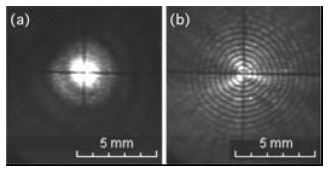Generation and Application of Bessel Beams in Alignment Tasks
Abstract
The divergence of a Gaussian laser beam is a limiting factor for optical alignment tasks at large distances. Bessel beams have almost zero divergence but are still not widely used. We discuss the construction of an alignment telescope based on Bessel beam generation using a commercial laser diode module. The Bessel beam is generated with conical or plano-convex lenses, and projected using a commercial CCD camera lens to extend the useful range of the beam. Our Bessel beams have diameters of between 0.5 – 1mm over beam lengths of 15m, representing a six-fold improvement compared to Gaussian beams, while the transverse beam structure (Bessel pattern) provides an excellent alignment aid for use with beam target. Another advantage of Bessel beams is their self-regeneration property, which allows the use of multiple beam targets with minimum beam degradation. We are using our alignment telescopes with crosshair targets to align optical components in a large astronomical telescope, and can achieve precisions of tens of microns over distances of 20m using purely visual methods.

This work is licensed under the Creative Commons Attribution-NonCommercial 4.0 International (CC BY-NC 4.0) license.








